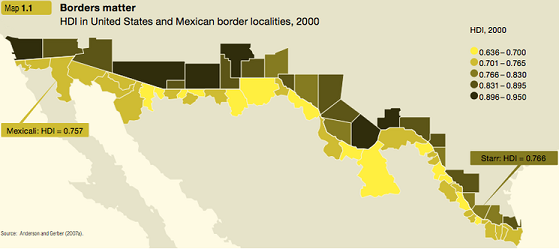Andrew Sullivan links to a map from the
2009 Human Development Report, which uses HDI, the Human Development Index, as a measure of the general level of development for jurisdictions on both sides of the US-Mexico border:

As Steven Taylor
notes:
What is interesting is that the lowest HDI county on the US side (Starr County Texas) is higher than the highest HDI municipality in Mexico (i.e., Mexicali).
This is, of course, likely not a shock to anyone paying even a modicum of attention to the situation. Still, it continues to underscore that fundamental aspect of this situation: it is the disparity of wealth between the two countries that continues to create the synergy of migration over the border. As I keep saying: any policy that ignores this fact will fail. As such, calls for massive deportations or that assumes it is possible to stop migration over the border is naught more than fantasy. “Seal the border!” is a slogan, not a viable policy.
That's true. It also points up what ought to be an obvious truth about immigration from Mexico and other relatively poor countries to the United States: it is comprised mostly of individuals who are driven by lack of economic opportunity to leave their homeland in order to exchange their labor for money. That many people feel so threatened by this class of people, which is already among the most powerless in society, has always baffled me.
Also: as long-time readers of this blog know, I like nothing better than using HDI for various countries as a frame of reference for apprehending the significance of HDI ratings for various sub-national jurisdictions! And so, here are selected HDI-comparable nations (based on
this table (pdf) from the same organization) for each of the five HDI ranges indicated on the map (with countries listed in ascending order of HDI):
.636-.700 - Morocco, Botswana, South Africa, Tajikistan, Vanuatu, Kyrgyzstan, Guatemala, Nicaragua
.701-.765 - Uzbekistan, Honduras, Egypt, Vietnam, Mongolia, Bolivia, Indonesia, Philippines, El Salvador, Algeria, China, Georgia
.766-.830 - Dominican Republic, Jordan, Belize, Tonga, Ukraine, Thailand, Peru, Turkey, Kazakhstan, Brazil, Serbia, Malaysia, Venezuela
.831-.895 - Panama, Bulgaria, Oman, Mexico, Costa Rica, Cuba, Argentina, Lithuania, Chile, Hungary, Malta
.896-.950 - Czech Republic, Portugal, UAE, Singapore, Slovenia, South Korea, Israel, Germany, UK, Italy, Belgium, United States



